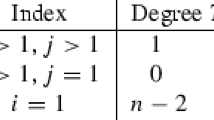Abstract
In this paper we prove that there is at most one complex number b for which the shifted Euler polynomial E n (x) + b has at most two zeros of odd multiplicity.
Similar content being viewed by others
References
M. Abramowitz and I. Stegun, Handbook of mathematical functions with formulas, graphs and mathematical tables, Dover, New York, 1972.
A. Baker, Bounds for the solutions of the hyperelliptic equation, Proc. Cambridge Philos. Soc., 65 (1969), 439–444.
J. Brillhart, On the Euler and Bernoulli polynomials, J. Reine Angew. Math., 234 (1969), 45–64.
B. Brindza, On S-integral solutions of the equation y m = f(x), Acta Math. Hungar., 44 (1984), 133–139.
G.-S. Cheon, A note on the Bernoulli and Euler polynomials, Appl. Math. Lett., 16 (2003), 365–368.
D. Cvijović and J. Klinowski, New formulae for the Bernoulli and Euler polynomials at rational arguments, Proc. Amer. Math. Soc., 123 (1995), 1527–1535.
H. Delange, On the real roots of Euler polynomials, Monatsh. Math., 106 (1988), 115–138.
A. Erdélyi, W. Magnus, F. Oberhettinger and F. G. Tricomi, Higher Transcendental Functions, I, McGraw-Hill, New York, 1953.
E. R. Hansen, A Table of Series and Products, Prentice Hall, Englewood Cliffs, NJ, 1975.
Hao Pan and Zhi-Wei Sun, New identities involving Bernoulli and Euler polynomials, J. Combin. Theory Ser. A, 113 (2006), 156–175.
F. T. Howard, Roots of The Euler polynomials, Pacific J. Math., 64 (1976), 181–191.
C. Jordan, Calculus of finite differences, Chelsea, New York, 1947.
W. J. LeVeque, On the equation y m = f(x), Acta Arith., 9 (1964), 209–219.
W. Magnus, F. Oberhettinger and R. P. Soni, Formulas and Theorems for the Special Functions of Mathematical Physics, Third Enlarged Edition, Springer-Verlag, New York, 1966.
Á. Pintér and Cs. Rakaczki, On the zeros of shifted Bernoulli polynomials, Appl. Math. Comput., 187 (2007), 379–393.
S. Selby, CRC Standard Mathematical Tables, 17th Edition, The Chemical Rubber Co., Cleveland, 1969.
H. M. Srivastava and J. Choi, Series Associated with the Zeta and Related Functions, Kluwer Academic, Dordrecht, 2001.
H. M. Srivastava and Á. Pintér, Remarks on some relationships between the Bernoulli and Euler Polynomials, Appl. Math. Lett., 17 (2004), 375–380.
Author information
Authors and Affiliations
Corresponding author
Additional information
Communicated by Attila Pethő
Supported in part, by Grants T48791 and F68872 form HNFSR, and by the Hungarian Academy of Sciences.
Rights and permissions
About this article
Cite this article
Rakaczki, C. On some diophantine results related to Euler polynomials. Period Math Hung 57, 61–71 (2008). https://doi.org/10.1007/s10998-008-7061-2
Received:
Accepted:
Published:
Issue Date:
DOI: https://doi.org/10.1007/s10998-008-7061-2



